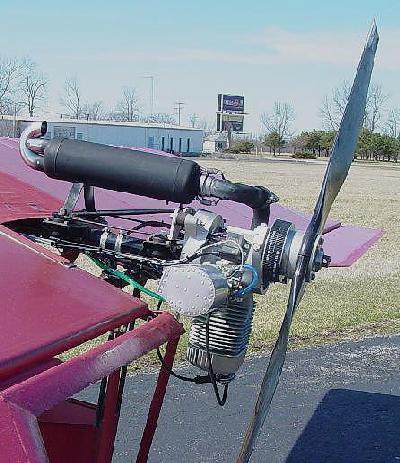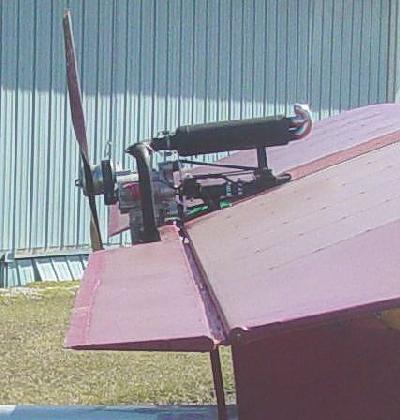|
|
 By inverting the engine the FireFly frontal profile drag is reduced. The fabric was removed from the upper longeron up to the engine mount to provide better air flow through the propeller and for engine cooling. And at the same time the engine is 100% exposed to take advantage of the 103-7 maximum engine drag coefficient.
By inverting the engine the FireFly frontal profile drag is reduced. The fabric was removed from the upper longeron up to the engine mount to provide better air flow through the propeller and for engine cooling. And at the same time the engine is 100% exposed to take advantage of the 103-7 maximum engine drag coefficient.
Since much of the engine frontal profile is blanked by the pilot, one would expect to see additional 103-7 performance gains. Due to a 40+ pound weight reduction, the FireFly wing should fly at a lower angle of attack with a corresponding lower wing drag coefficient. |
 With the engine mounted in this manner, the wings can not be folded. To enable wing folding the engine would have to be mounted about three inches higher, and the vertical exhaust pipe section would have to be moved closer to the engine center line. Since I do not fold the wings, I went for the lower profile drag position.
With the engine mounted in this manner, the wings can not be folded. To enable wing folding the engine would have to be mounted about three inches higher, and the vertical exhaust pipe section would have to be moved closer to the engine center line. Since I do not fold the wings, I went for the lower profile drag position.
The belt reducing unit is mounted with three bolts, so one does not have as many options as with the Victor 1+ to offset the propeller. |
 One can see that the air filter scoop comes very close to the stream lined aileron torque tube. On the opposite side a bit of the stream lining had to be cut away to clear the exhaust pipe.
One can see that the air filter scoop comes very close to the stream lined aileron torque tube. On the opposite side a bit of the stream lining had to be cut away to clear the exhaust pipe.
In an attempt to further reduce engine and propeller induced vibration to the fuselage cage, the engine is double mounted. The original Lord mounts are used in addition to bulk head mounts. The muffler is supported solely by the Lord mounts. The exhaust pipe system is supported between the Lord and bulkhead mounts. |
 Here one can see how close the aileron torque tube comes to the exhaust pipe. To extend to original exhaust pipe a second pipe was purchased. This gave the necessary elbow to make up the gap between the original pipe and the desired muffler position. To connect the two ends a ball joint was purchased and welded into place. By doing so, this gives the necessary degrees of freedom or flexure to the system.
Here one can see how close the aileron torque tube comes to the exhaust pipe. To extend to original exhaust pipe a second pipe was purchased. This gave the necessary elbow to make up the gap between the original pipe and the desired muffler position. To connect the two ends a ball joint was purchased and welded into place. By doing so, this gives the necessary degrees of freedom or flexure to the system.
As there is adequate blade clearance, no propeller extension was used. FireFly empty CG for the MZ 34 is slightly forward of that for the Rotax 447. The easiest way to determine CG movement is to calculate the percent of weight exerted by the tail wheel to total main wheel weight. With the fuel tank full, no pilot, the FireFly with the Rotax 447, the tail wheel carried 20.6%, with the MZ 34 it is 18.9% Ready for the first flight, the empty weight was 213.5 pounds and this includes 1.75 pound seat cushion and cheek board plus about 0.5 pounds of dust. |